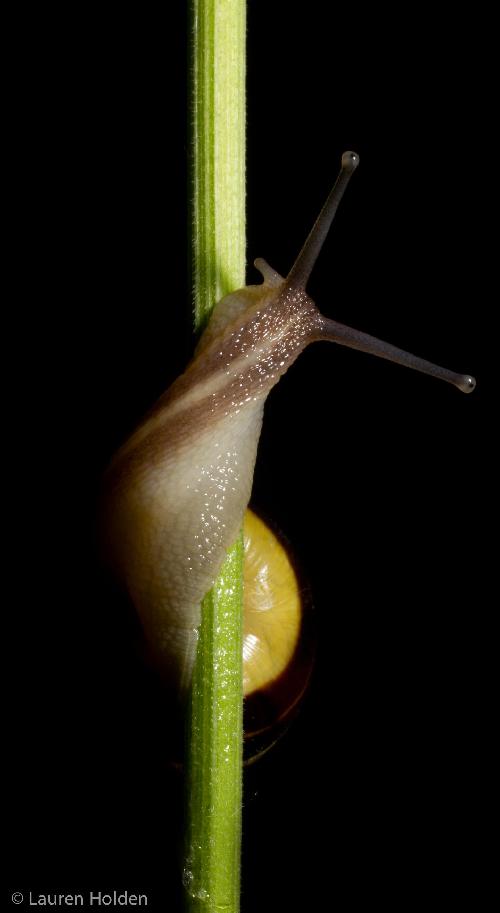While people and many animals might look pretty symmetrical on the outside, inside our bodies we are all fundamentally asymmetric. For example, the human heart is found to the left of center. Snails are similarly asymmetric in their appearance, and more obviously so: the shells and bodies of some snails twist around to the right, whereas others twist to the left.
Now researchers reporting in the Cell Press journal Current Biology on February 25 have an idea how it works. And, surprisingly enough, it turns out that the gene responsible for the variably asymmetrical bodies of some snail species also plays a role in defining the internal asymmetries in frogs.
The findings reveal that asymmetry is an evolutionarily ancient characteristic of animal body plans, the researchers say.
 This is a photograph of the grove snail (Cepaea nemoralis) twisting around a plant stem. Credit: Lauren Holden.
This is a photograph of the grove snail (Cepaea nemoralis) twisting around a plant stem. Credit: Lauren Holden.
"Animals tend to be outwardly symmetric in appearance but are almost all asymmetrical inside," says Angus Davison of The University of Nottingham. "It hasn't been clear if asymmetry is an ancient feature or something that has evolved several times. By identifying an evolutionarily conserved protein that controls asymmetry in both snails and frogs, we have shown that body asymmetry in most animals, including humans, likely arises from a highly conserved, intrinsic asymmetry of the cells in the early embryo."
Davison says he first got intrigued with snail shell coiling when he was living in Japan in 2001 and he noticed that the snails around him were twisting in what he considered to be the "wrong" direction. Ever since then, he has wanted to find the gene responsible for this switch.
In the new study, he and his colleagues sequenced the genome of a pond snail species that shows variation in the coiling direction of its shells. They then used genetic mapping techniques to narrow the list of potential gene candidates down to six. They knew they'd found what they were looking for when they landed a mutation in one gene that rendered it inactive in the anti-clockwise coiling form of the snail. That mutation appeared in a gene called formin.
The researchers went on to show that this gene is active in just the right place in early embryos. They also found that an anti-formin drug treatment delivered to developing snails could partially convert clockwise twisting snails to mirror-image snails that twist the other way. Ultimately, those snails didn't survive, but the findings showed that formin worked in the way they suspected.
"We were surprised to find that asymmetry is present in the very early embryo, from the two-cell stage onwards," says Dan Jackson of the University of Göttingen, Germany.
Those findings in snails led them to wonder whether the same gene has a similar function in specifying left-right asymmetry in developing frog embryos. And, it turns out, it does.
The new evidence leads the researchers to suggest that formin is among the earliest "symmetry-breaking" molecular components across all animals with bilateral symmetry, meaning animals with bodies that have an obvious left and right side. (Bilateral symmetry is in contrast to radial symmetry, found in jellyfish and sponges, for example.)
"This work supports a unified evolutionary view by showing that even vertebrates initiate asymmetry very early in development using the same intracellular toolkit as invertebrates," Davison says.
He says they now hope to further explore the intricacies of the symmetry-breaking switch in pond snails. They'll also examine other snails that exist in mirror-image forms in nature in search of more asymmetry genes.
source: Cell Press